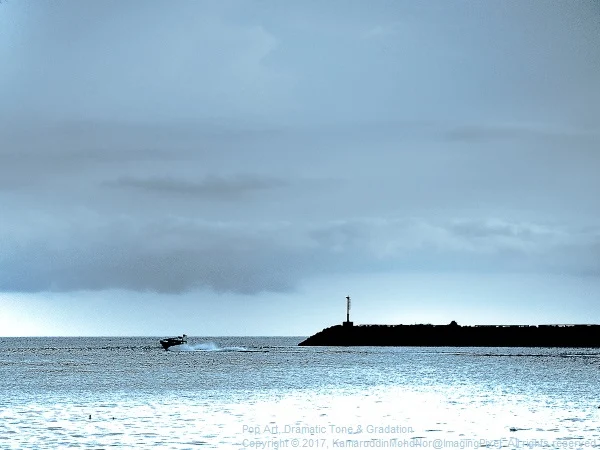How is your day, today? I am sure you too have your days when things just do not turn out right or worked out the way you wanted them to. That was what happened to me when I was on one of my outstation trips, where I ended up in a small settlement striding the estuary of a river that provides both fishing and tourism as the main economic activity of the district. I took a few shots of the scenes while fussing that the weather wasn't kind enough to me for the day. The image, as you can see below, is nowhere near exciting.
 |
| Image as captured in RAW |
Pop Art Filter Effect
One option I had with the *.orf RAW images was to post-process them on Olympus Viewer 3 (OV3) and re-built the images with enhancements from art filter effects and other editing features. I started to work on a few and came out pretty excited with the outcome. One of the images in the header image (above) was enhanced with the Pop Art art filter effect and tweaked with Brightness & Contrast in JPEG mode, and Unsharp Mask, Exposure Compensation, Highlight & Shadow Control, and Gradation in RAW development mode.
 |
| Same image as the header |
For the image above, Color Balance was used to reduce the Red channel (-10) and to increase the Green (+5) and Blue (+10) channels. Saturation was boosted up (+60) on the Hue & Saturation feature. What I have done here is to give the image an uplift almost into the surreal, yet keeping it still within the ambiance of its original environment.
Art filter effects do not come with any user-defined variables, so all the results of their application are fixed. You can, however, blend the effect with other editing features to further enhance or fine-tune the image you are editing. The following is a sample that was enhanced with the Dramatic Tone effect blended with Gradation features.
Dramatic Tone Filter Effect
Dramatic Tone art filter highlights the lighter parts of an image while simultaneously darkening the darker aspects like shadows, making the image more contrasty and foreboding. The effect also washes out the colors slightly, giving it a retro feel.
 |
| Image with Dramatic Tone art filter effect |
Gradation Feature
The Gradation feature, which has a value scale of four (4) options, further affects the brightness and contrast of the image being processed, enhancing it in a way that you can be really creative about.
When blended with the Dramatic Tone filter effect, the Gradation feature shows the following visual effects:
 |
| Normal - No gradation algorithms are applied to the image. The image can also be used with the Auto Tone Correction feature which will add a nice perk to a flat or under-exposed image |
 |
| Low Key - Gradation is applied that best suits a dark subject that Normal gradation would process to be lighter. It can be used to make images that have a somewhat somber mood. |
 |
| High Key - Gradation is applied that best suits a bright subject, such as silhouettes on a foggy day. It processes images so they are bright with slightly higher contrast in the brightest areas. |
If you are doing any of these steps in-camera, make sure that you set the variables carefully, and take a separate shot of each environment. For the Gradation feature, for example, take four shots one each at the appropriate setting. Please remember to change the variable back to its original setting after the shots.
For what it's worth, my preference is still for the convenience of working on those images during post-processing.














No comments:
New comments are not allowed.